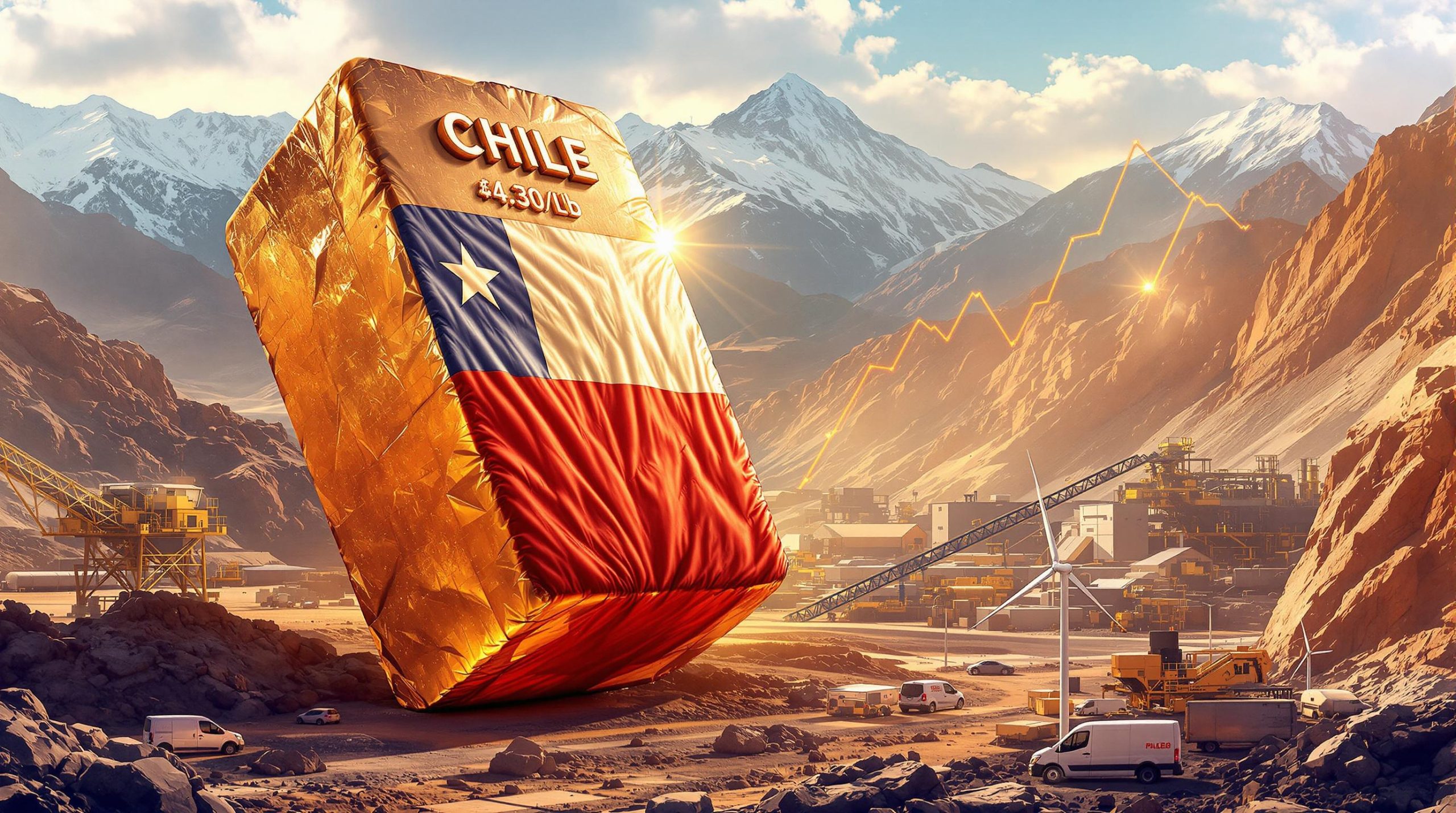What Is Driving the Energy Transition?
The Shift from Traditional Resource Investment to Decarbonization
The global resources sector has undergone a fundamental transformation in recent years, evolving from traditional commodity-focused investment to a more integrated approach encompassing the entire energy transition ecosystem. This shift represents more than just a change in investment focus—it signals a complete restructuring of how we think about energy production, distribution, and consumption.
The decarbonization imperative has become the primary catalyst for this transformation. According to industry experts, growing climate concerns coupled with technological advancements have created an unprecedented push toward cleaner energy solutions. This transition isn't merely environmental—it's increasingly economic as renewable technologies achieve cost parity with conventional energy sources.
"The intersection of upstream and downstream analysis has become very important as these things are changing, and geopolitics are increasingly influential in determining which resources get developed and where," explains Scott Clemens of Tribeca Capital, highlighting how the traditional boundaries between resource extraction and technology applications are blurring.
Key Decarbonization Technologies Creating Market Demand
The acceleration of decarbonization efforts has created surging demand for specific minerals and metals essential to emerging clean technologies. Nuclear energy revival, battery storage advancements, and renewable energy infrastructure are reshaping global resource demand patterns in profound ways.
Nuclear power, once sidelined in many markets, is experiencing a significant renaissance. Singapore's recent evaluation of nuclear energy as a viable low-carbon solution exemplifies this shift, with 23 countries currently considering new nuclear programs according to the World Nuclear Association. This revival is creating renewed demand for uranium despite recent uranium market volatility over the past six to nine months.
Battery technology advancement represents another critical demand driver. The exponential growth in electric vehicle production has transformed lithium, cobalt, nickel, and graphite from specialty minerals into mainstream commodities. However, this sector faces complex supply-demand dynamics, with some materials experiencing temporary oversupply while long-term demand trajectories remain robust.
Renewable energy infrastructure—particularly wind, solar, and transmission systems—has created unprecedented demand for copper, aluminum, rare earth elements, and specialized steel alloys. These technologies require significantly higher mineral inputs per unit of energy produced compared to traditional fossil fuel infrastructure, magnifying the resource intensity of the energy transition and decarbonization.
How Are Geopolitical Tensions Reshaping Resource Supply Chains?
Friend-Shoring and the New Geography of Mining
The concept of "friend-shoring" has emerged as a dominant force reshaping global resource supply chains. Western nations are increasingly prioritizing resource security through partnerships with politically aligned countries, fundamentally altering investment patterns in the mining sector.
This geopolitical shift means that even suboptimal mining assets in favorable jurisdictions may secure development funding, while superior deposits in geopolitically complex regions face mounting challenges attracting investment. The impact is particularly pronounced for critical minerals transition deemed essential for both economic security and defense applications.
"In today's environment, substandard assets in favorable jurisdictions may secure funding, while superior deposits in complex regions face significant challenges," notes Clemens, highlighting how geopolitical considerations now often outweigh purely economic or geological factors in investment decisions.
This realignment reflects growing awareness of supply chain vulnerabilities exposed during recent global crises. Western nations have recognized their dependence on potentially unreliable sources for materials critical to both the energy transition and defense technologies. The resulting policy shifts are creating investment opportunities in previously overlooked mining jurisdictions within politically aligned countries, while simultaneously raising risks for projects in nations perceived as geopolitically complex.
The Impact of Trade Tensions on Critical Mineral Development
Recent trade tensions have dramatically accelerated the restructuring of global supply chains, particularly for materials deemed strategic for industrial and defense applications. The Inflation Reduction Act (IRA) in the United States marked a watershed moment by creating powerful incentives for domestic production of critical minerals.
The IRA, initiated under the Biden administration (2021-2025), established preferential treatment for electric vehicles and renewable energy technologies using materials processed or mined within the United States or from free-trade agreement partners. This policy shift, which continues under the current administration, represents a fundamental change in how governments approach resource security.
These trade policy developments have significant implications for mining companies and investors. Projects located within the U.S. or allied nations can potentially access enhanced financing options, tax benefits, and guaranteed offtake agreements that weren't previously available. Conversely, operations in non-aligned countries face increasing obstacles despite potentially superior geology or economics.
The long-term consequence is a more fragmented, regionally-focused approach to mineral development that prioritizes security over pure economic efficiency. For investors, this fragmentation creates both risks and opportunities—understanding the geopolitical landscape has become as essential as analyzing geological data or operational metrics.
Which Commodities Are Positioned to Benefit from Decarbonization?
Copper: The Foundation Metal of Electrification
Copper stands at the epicenter of the energy transition as the essential foundation metal for global electrification efforts. Despite experiencing short-term price volatility tied to macroeconomic concerns, copper faces a fundamental medium-term supply shortage as electrification accelerates worldwide.
"Copper is somewhat schizophrenic—it functions both as a green transition metal and as a proxy for Chinese industrial growth," explains Clemens, highlighting the metal's unique dual role in the global economy. This duality creates a compelling investment case despite market uncertainty.
The International Copper Study Group projects a significant supply gap emerging by 2030, with demand growth outpacing new mine development. This imbalance stems from several factors:
- Electrification intensity: Electric vehicles require approximately 4× more copper than conventional vehicles
- Renewable energy systems: Wind and solar installations use 2-5× more copper per megawatt than fossil fuel plants
- Grid infrastructure upgrades: Modernizing and expanding transmission networks demands enormous copper inputs
- Development timelines: New copper mines typically require 7-10 years from discovery to production
- Declining ore grades: Average copper grades have fallen nearly 25% over the past decade
These structural factors suggest that even temporary price weakness may create strategic entry opportunities for long-term investors. Companies with advanced copper projects in stable jurisdictions may be particularly well-positioned to benefit from this fundamental supply-demand imbalance.
Furthermore, recent copper price insights indicate the metal may reach unprecedented valuations as the energy transition accelerates across global economies.
Uranium: Nuclear Renaissance Driving Long-Term Demand
The nuclear energy sector has experienced a profound renaissance globally, with countries from Singapore to Europe reevaluating nuclear power as a low-carbon baseload energy solution. This shift represents a remarkable turnaround for a sector that many had written off following the Fukushima disaster in 2011.
While uranium prices have experienced significant volatility, the fundamental case for nuclear power has strengthened considerably. Several factors support this nuclear revival:
"The uranium thesis remains intact for patient investors. The world needs reliable baseload power that doesn't produce carbon emissions, and nuclear provides exactly that," notes Clemens.
Key drivers supporting uranium's long-term outlook include:
- Climate imperatives: Growing recognition that climate targets are unachievable without nuclear expansion
- Energy security concerns: Nations seeking to reduce dependence on imported fossil fuels
- Technology advances: Small modular reactors offering improved safety and flexibility
- Supply constraints: Decades of underinvestment limiting production capability
- Inventory depletion: Utilities drawing down stockpiles accumulated after Fukushima
For investors, this creates a potentially compelling opportunity in well-positioned uranium producers and developers, particularly those operating in politically stable jurisdictions. However, the sector's inherent volatility and sensitivity to policy decisions necessitates a patient investment approach focused on companies with strong balance sheets and low production costs.
What Investment Strategies Work in the Energy Transition Space?
Integrating Upstream and Downstream Analysis
Successful investment in the energy transition requires a sophisticated understanding of both the resource extraction (upstream) and technology application (downstream) aspects of complex supply chains. This integrated approach helps identify which technologies may drive substitution of key commodities and which upstream resources face supply constraints that could impact technology deployment.
"The intersection of upstream and downstream has been very important in our analysis," emphasizes Clemens. "Understanding both ends of the supply chain provides critical insights into potential bottlenecks and opportunities."
Effective integrated analysis involves several key components:
- Technology adoption curves: Assessing realistic deployment timelines for emerging technologies
- Substitution potential: Evaluating the feasibility of alternative materials in key applications
- Processing bottlenecks: Identifying constraints beyond mining in refining, processing, or manufacturing
- Policy impacts: Analyzing how government interventions affect different parts of the supply chain
- Competitive dynamics: Understanding how technology choices influence commodity demand
For investors, this integrated perspective helps avoid the common pitfall of focusing exclusively on either resource scarcity or technology hype without considering how these factors interact dynamically. The most successful investments typically emerge from identifying misalignments between upstream development timelines and downstream technology adoption rates.
Navigating Market Cyclicality Through Fundamental Analysis
The resources sector remains inherently cyclical, with timing critical to investment success. During periods of market uncertainty and reduced financing activity, significant opportunities emerge for investors with longer time horizons who can identify fundamentally sound projects positioned to benefit from structural supply-demand imbalances.
"Fundamentals ultimately win out in this space," notes Clemens. "Good assets managed by good teams will eventually succeed, even if timing uncertainty creates near-term volatility."
Effective fundamental analysis in cyclical resource markets requires:
- Cost curve positioning: Focusing on assets in the lowest quartile of production costs
- Balance sheet strength: Prioritizing companies with sufficient funding to weather downturns
- Management quality: Evaluating teams with proven track records through market cycles
- Permitting progress: Assessing regulatory pathway clarity, particularly in critical minerals
- Offtake security: Valuing projects with established partnerships with end-users
This approach is particularly valuable during periods of reduced market liquidity when quality assets may be mispriced due to temporary sentiment factors rather than fundamental changes in long-term supply-demand dynamics. Patient capital can often secure positions in premium assets during such periods of dislocation.
How Are Corporate Advisory Services Evolving in the Resource Sector?
Addressing Client Concerns in an Uncertain Market Environment
Resource companies are grappling with unprecedented uncertainty related to recession risks, supply chain disruptions, and financing challenges. Corporate advisors are increasingly focused on helping clients navigate these complexities while positioning for long-term opportunities in the energy transition space.
"Everyone's confused about the current environment," observes Clemens. "Companies are seeking guidance on both near-term survival strategies and long-term positioning for the energy transition."
The most pressing client concerns include:
- Recessionary pressures: Balancing cost discipline with strategic growth initiatives
- Financing availability: Adapting to changing capital market conditions and investor preferences
- Supply chain resilience: Developing strategies to mitigate geopolitically-driven disruptions
- Regulatory navigation: Managing increasingly complex permitting and compliance requirements
- Strategic partnerships: Identifying optimal industry alliances to enhance project development
Corporate advisors are responding by developing more sophisticated scenario planning capabilities, strengthening connections with diverse capital sources, and building deeper expertise in critical minerals and decarbonization technologies. This evolution represents a significant shift from traditional advisory models focused primarily on transaction execution toward more holistic strategic partnerships.
Capital Markets Activity Across Different Resource Segments
Financing activity across the resources sector has been strikingly uneven, with gold benefiting from its safe-haven status while battery materials face more challenging market conditions. This disparity reflects both the current macroeconomic environment and investor uncertainty about the pace and direction of the energy transition.
"Gold benefits from the uncertainty, while battery materials are struggling with oversupply concerns and market skepticism about electrification timelines," explains Clemens.
The current financing landscape shows distinct patterns:
- Gold sector: Strong investor interest, reliable access to equity markets, premium valuations
- Copper developers: Selective funding available for advanced projects in favorable jurisdictions
- Battery materials: Challenging conditions with reduced retail interest and temporary oversupply
- Uranium: Patient institutional capital focusing on producers and near-term developers
- Critical minerals: Strategic funding available for projects aligned with security priorities
This fragmented market creates both challenges and opportunities for companies seeking capital. The most successful financing strategies typically involve targeting specific investor segments with tailored messaging rather than pursuing broad market approaches. Companies that can clearly articulate how their projects address specific supply chain vulnerabilities or align with geopolitical priorities have demonstrated superior capital-raising capabilities.
What Are the Long-Term Investment Opportunities in Decarbonization?
Identifying Quality Assets in Critical Mineral Supply Chains
Despite short-term market volatility, well-managed companies with quality assets in critical mineral supply chains remain positioned for long-term success. The fundamental drivers of the energy transition—electrification, renewable energy deployment, and decarbonization policies—continue to strengthen despite near-term market fluctuations.
"The basic thesis remains intact," emphasizes Clemens. "The world needs these materials to transition to cleaner energy, and the best projects will eventually get developed."
Key characteristics defining quality assets include:
- Grade advantage: Superior mineral content providing cost resilience through cycles
- Infrastructure access: Proximity to existing transportation and energy infrastructure
- Permitting progress: Advanced regulatory approvals reducing development timeline uncertainty
- ESG performance: Strong environmental and social practices enhancing project viability
- Technological edge: Innovative processing approaches improving recovery or reducing costs
Companies possessing these attributes in critical minerals like copper, nickel, lithium, rare earths, and graphite may represent compelling long-term investments despite current market uncertainty. The structural supply deficits projected for many of these materials suggest potential for significant value appreciation as decarbonization accelerates globally.
Recent developments in battery recycling breakthrough technologies may also influence long-term supply dynamics for certain critical minerals.
Taking Advantage of Market Uncertainty for Strategic Positioning
Periods of market uncertainty and reduced liquidity often create exceptional entry opportunities for investors with longer time horizons. Companies with strong management teams and high-quality assets in commodities with favorable long-term fundamentals may present compelling value during market downturns.
"Patient capital with a fundamental focus can find extraordinary opportunities during periods of market dislocation," notes Clemens.
Effective strategies for capitalizing on market uncertainty include:
- Counter-cyclical investment: Acquiring quality assets when financing constraints limit competition
- Strategic partnerships: Forming alliances with end-users seeking supply security
- Project optimization: Using market slowdowns to enhance project economics and design
- Talent acquisition: Attracting experienced technical teams from struggling competitors
- Distressed acquisitions: Securing complementary assets at advantageous valuations
Historical analysis demonstrates that resource companies that expanded strategically during downturns often emerged as sector leaders during subsequent recovery phases. However, successful execution requires both financial resilience to withstand extended periods of market weakness and disciplined focus on fundamental asset quality rather than speculative positioning.
Additionally, understanding governmental policies like the recent critical minerals order can provide investors with insights into future market directions and potential opportunities.
FAQ: Energy Transition and Resource Investment
How is the battery materials market expected to evolve?
The battery materials market faces near-term challenges related to oversupply in some segments and geopolitical complications. Lithium prices have declined significantly from their 2022 peaks, creating financial pressure for higher-cost producers and speculative projects without clear competitive advantages.
However, long-term demand growth driven by electric vehicle adoption and energy storage deployment suggests eventual market rebalancing, particularly for materials with constrained supply potential. According to Benchmark Mineral Intelligence, despite current oversupply conditions, lithium demand is projected to grow fourfold by 2030, eventually outpacing production capacity.
Key factors shaping the battery materials outlook include:
- Chemistry evolution: Shifting cathode formulations altering specific material demand
- Recycling development: Emerging closed-loop systems reducing primary material requirements
- Regional processing: Localization of supply chains creating differential pricing by geography
- Qualification timelines: Extended testing periods required for new material sources
- Resource nationalism: Government interventions affecting investment and trade patterns
For investors, this complex landscape suggests focusing on lowest-quartile cost producers with established customer relationships rather than speculative development projects without clear differentiation. The sector remains essential to decarbonization but requires careful asset selection and realistic timelines.
What impact will artificial intelligence have on resource demand?
AI infrastructure development is creating significant new demand for specific metals and minerals, particularly those used in data centers and advanced computing hardware. This technological shift represents an additional demand driver beyond traditional energy transition applications.
The U.S. Department of Energy has identified several critical minerals facing increased demand from AI infrastructure development:
- Copper: Essential for data center power distribution and cooling systems
- Rare earth elements: Required for high-performance computing components
- Specialized cooling materials: Used in advanced thermal management systems
- Gallium and indium compounds: Utilized in semiconductor manufacturing
- Energy storage metals: Needed for backup power and grid stability systems
This AI-driven demand layer adds complexity to resource forecasting but potentially enhances the investment case for certain materials, particularly those facing supply constraints. Companies with diversified exposure to both energy transition and digital infrastructure metals may benefit from this converging demand pattern.
How might changing interest rate environments affect resource investments?
Resource development projects are typically capital-intensive with long development timelines, making them sensitive to interest
Ready to Spot the Next Major Mineral Discovery?
Discovery Alert's proprietary Discovery IQ model provides instant notifications of significant ASX mineral discoveries, transforming complex data into actionable investment opportunities. Explore our dedicated discoveries page to understand why major mineral discoveries can lead to substantial returns and begin your 30-day free trial today to position yourself ahead of the market.




